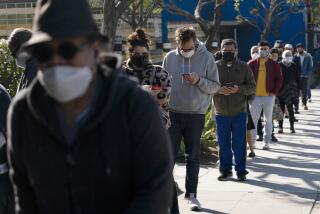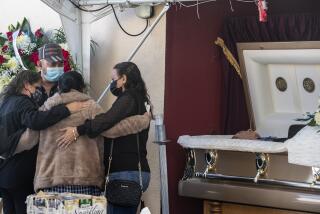America’s coronavirus response is as racist as its policing
- Share via
There are a gratifying number of private and public discussions underway this week in Los Angeles and elsewhere about how Black, Latino, and other communities of color have borne a disproportionate share of the impacts of the COVID-19 pandemic, most notably deaths and financial hardships, and the role that systemic racism has played in such outcomes. It’s a natural outgrowth of the protests over George Floyd’s death in Minneapolis police custody and the nationwide reckoning they prompted over the endemic racism built into civic and cultural institutions.
And happily, these discussions are translating into some action locally to adjust the ongoing pandemic response. On Tuesday the Los Angeles County Board of Supervisors agreed to ramp up coronavirus testing, tracing and outreach in hard-hit communities of color by enlisting community based organizations to help with the legwork. This is welcome and appropriate, albeit somewhat belated — the Advancement Project California, a nonprofit that promotes racial equity, proposed this model more than a month ago.
We’d like to see similar approaches in other cities and states. The data on COVID-19 cases and deaths suggest that our collective response to the pandemic has been as fundamentally, if unconsciously, racist as the policing tactics that led to the deaths of Floyd, Breonna Taylor and far too many other Black Americans.
If only if hadn’t taken four months of sickness and dying and a widespread civil unrest for this problem to get the attention and action it deserves. Because it was no surprise. Even in the early days of the first wave of COVID-19, there was evidence that Black people were succumbing to the effects of infection at a much higher rate than white people.
Michigan authorities were reporting in early April that while 14% of the state’s population is Black, that community accounted for 41% of deaths. Similar disparities were being reported in Chicago and Louisiana. It’s the same in Los Angeles, too, although the disparities included Latinos and other communities of color. New data show nonwhites in Los Angeles are more likely to have died of COVID-19 at twice the rate of white residents.
Communities of color historically have had worse health outcomes, from the beginning of their lives to the foreshortened ends. They have less access to healthcare. They are more likely than white people to develop conditions such as asthma, diabetes and heart disease that put them at higher risk for serious complications and death from COVID-19. They are more likely to live in crowded conditions where it’s more difficult to socially distance. The list of contributing factors goes on and on.
Nor was it a secret that Black people and Latinos would be more exposed to the coronavirus because they are much less likely to hold jobs that can be done from home. Yet they are also overrepresented in service jobs hard hit by the restrictions imposed on businesses during the pandemic, so they’ve suffered disproportionately from the ensuing layoffs, furloughs and cutbacks.
How was this going to happen any other way, considering the disparities in healthcare, employment, accumulated wealth and education that put communities of color at an immediate disadvantage in every crisis? Obviously, the nation needs serious reform in healthcare along with criminal justice. But right now, we need immediate action to prevent Black people, Latinos, Native Americans and other ethnic communities from suffering and dying at frightening rates. Because here’s another thing we know: Coronavirus is still circulating all over the U.S., and people are still dying from COVID-19. And they will likely do so for the foreseeable future.
More to Read
A cure for the common opinion
Get thought-provoking perspectives with our weekly newsletter.
You may occasionally receive promotional content from the Los Angeles Times.









